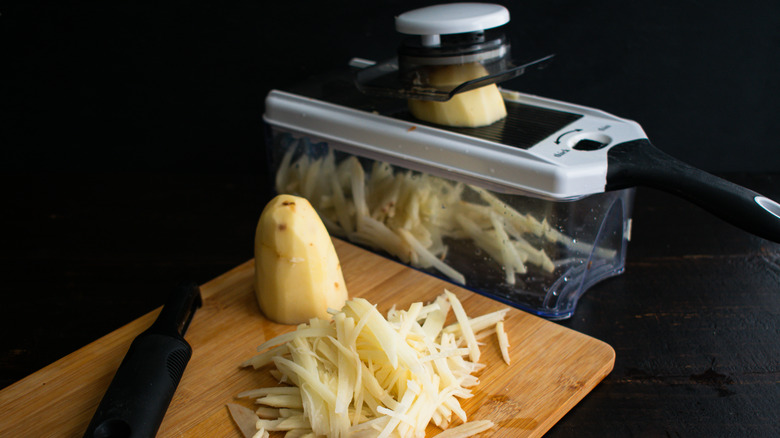The One Kitchen Tool Aarón Sánchez Can't Live Without
Aarón Sánchez was an accomplished chef and restaurateur long before he launched his successful television career. The "Chopped" judge and star of Food Network's "Heat Seekers" and the Cooking Channel's "Taco Trip" is a chef-partner of the Johnny Sánchez restaurant in New Orleans (per Food Network), and before that, he opened and ran New York's Centrico restaurant and Leawood, Kansas' Mestizo (via Institute of Culinary Education).
A graduate of Johnson & Wales University (via Society 19), Sánchez is a master of culinary techniques, and as a successful professional and television star, has access to the best culinary tools and equipment. So when it comes to slicing vegetables, like onions and potatoes, what type of utensil does the acclaimed chef choose? The author of "La Comida del Barrio" and "Simple Food, Big Flavor: Unforgettable Mexican-Inspired Recipes from My Kitchen to Yours" says the one kitchen tool he can't live without is the Japanese mandoline.
Even if you've never used a mandoline, you're probably familiar with the tool. This cutting utensil is used to slice vegetables and fruits into different cuts, including disks and juliennes (per La Cucina Italiana). It features a plate made of wood, metal, or plastic, and has a blade that is fitted horizontally into the plate. The plate and blade remain stationary while the user draws the vegetable or fruit across the blade to cut it. Some also come with a holder which grasps the vegetable so hands stay protected.
Aarón Sánchez swears by this cutting tool
When asked by the Food Network, Sánchez said the one tool he can't live without is the Japanese mandoline. Mandolines are a great tool for slicing and cutting foods quickly, but what exactly is a Japanese mandoline and how does it differ from a traditional French mandoline?
Both French and Japanese mandolines come with several blades that can be switched for various styles of cuts, including julienning, slicing, and ridge shapes for different applications, such as salads, slaws, or french fries (via Nomlist). However, Japanese mandolines are lighter and slightly smaller than their heftier French counterparts. Japanese mandolines, because they are lighter and less substantial, are more affordable than their restaurant-grade French cousins.
Nomlist says that the biggest difference, however, lies in the blades of the Japanese mandolines. The blades are set diagonally, versus straight across the plate, which allows for more control for the user and a cleaner slice. Japanese mandolines also feature knobs that allow the user to adjust the thickens of the slices the mandoline will produce. Moreover, the website points out that Japanese steel blades are considered the best in the industry, and this helps to produce cleaner and more even slices.

